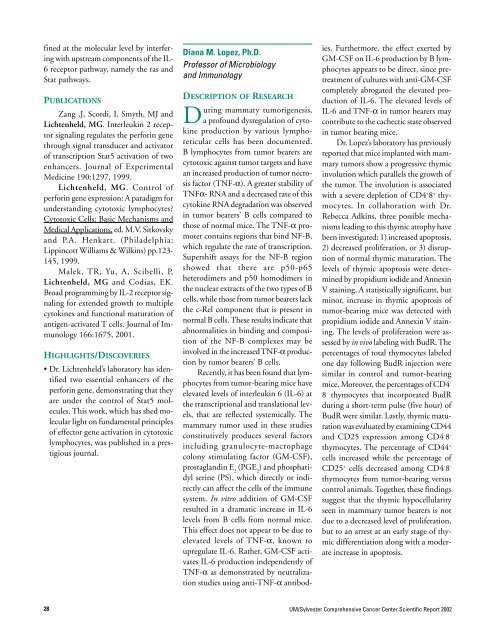tumor cell biology program - Sylvester Comprehensive Cancer Center
tumor cell biology program - Sylvester Comprehensive Cancer Center
tumor cell biology program - Sylvester Comprehensive Cancer Center
Create successful ePaper yourself
Turn your PDF publications into a flip-book with our unique Google optimized e-Paper software.
fined at the molecular level by interfering<br />
with upstream components of the IL-<br />
6 receptor pathway, namely the ras and<br />
Stat pathways.<br />
PUBLICATIONS<br />
Zang ,J, Scordi, I, Smyth, MJ and<br />
Lichtenheld, MG. Interleukin 2 receptor<br />
signaling regulates the perforin gene<br />
through signal transducer and activator<br />
of transcription Stat5 activation of two<br />
enhancers. Journal of Experimental<br />
Medicine 190:1297, 1999.<br />
Lichtenheld, MG. Control of<br />
perforin gene expression: A paradigm for<br />
understanding cytotoxic lymphocytes?<br />
Cytotoxic Cells: Basic Mechanisms and<br />
Medical Applications, ed. M.V. Sitkovsky<br />
and P.A. Henkart. (Philadelphia:<br />
Lippincott Williams & Wilkins) pp.123-<br />
145, 1999.<br />
Malek, TR, Yu, A, Scibelli, P,<br />
Lichtenheld, MG and Codias, EK.<br />
Broad <strong>program</strong>ming by IL-2 receptor signaling<br />
for extended growth to multiple<br />
cytokines and functional maturation of<br />
antigen-activated T <strong>cell</strong>s. Journal of Immunology<br />
166:1675, 2001.<br />
HIGHLIGHTS/DISCOVERIES<br />
• Dr. Lichtenheld’s laboratory has identified<br />
two essential enhancers of the<br />
perforin gene, demonstrating that they<br />
are under the control of Stat5 molecules.<br />
This work, which has shed molecular<br />
light on fundamental principles<br />
of effector gene activation in cytotoxic<br />
lymphocytes, was published in a prestigious<br />
journal.<br />
Diana M. Lopez, Ph.D.<br />
Professor of Micro<strong>biology</strong><br />
and Immunology<br />
DESCRIPTION OF RESEARCH<br />
During mammary <strong>tumor</strong>igenesis,<br />
a profound dysregulation of cytokine<br />
production by various lymphoreticular<br />
<strong>cell</strong>s has been documented.<br />
B lymphocytes from <strong>tumor</strong> bearers are<br />
cytotoxic against <strong>tumor</strong> targets and have<br />
an increased production of <strong>tumor</strong> necrosis<br />
factor (TNF-α). A greater stability of<br />
TNFα- RNA and a decreased rate of this<br />
cytokine RNA degradation was observed<br />
in <strong>tumor</strong> bearers’ B <strong>cell</strong>s compared to<br />
those of normal mice. The TNF-α promoter<br />
contains regions that bind NF-B,<br />
which regulate the rate of transcription.<br />
Supershift assays for the NF-B region<br />
showed that there are p50-p65<br />
heterodimers and p50 homodimers in<br />
the nuclear extracts of the two types of B<br />
<strong>cell</strong>s, while those from <strong>tumor</strong> bearers lack<br />
the c-Rel component that is present in<br />
normal B <strong>cell</strong>s. These results indicate that<br />
abnormalities in binding and composition<br />
of the NF-B complexes may be<br />
involved in the increased TNF-α production<br />
by <strong>tumor</strong> bearers’ B <strong>cell</strong>s.<br />
Recently, it has been found that lymphocytes<br />
from <strong>tumor</strong>-bearing mice have<br />
elevated levels of interleukin 6 (IL-6) at<br />
the transcriptional and translational levels,<br />
that are reflected systemically. The<br />
mammary <strong>tumor</strong> used in these studies<br />
constitutively produces several factors<br />
including granulocyte-macrophage<br />
colony stimulating factor (GM-CSF),<br />
prostaglandin E 2<br />
(PGE 2<br />
) and phosphatidyl<br />
serine (PS), which directly or indirectly<br />
can affect the <strong>cell</strong>s of the immune<br />
system. In vitro addition of GM-CSF<br />
resulted in a dramatic increase in IL-6<br />
levels from B <strong>cell</strong>s from normal mice.<br />
This effect does not appear to be due to<br />
elevated levels of TNF-α, known to<br />
upregulate IL-6. Rather, GM-CSF activates<br />
IL-6 production independently of<br />
TNF-α as demonstrated by neutralization<br />
studies using anti-TNF-α antibodies.<br />
Furthermore, the effect exerted by<br />
GM-CSF on IL-6 production by B lymphocytes<br />
appears to be direct, since pretreatment<br />
of cultures with anti-GM-CSF<br />
completely abrogated the elevated production<br />
of IL-6. The elevated levels of<br />
IL-6 and TNF-α in <strong>tumor</strong> bearers may<br />
contribute to the cachectic state observed<br />
in <strong>tumor</strong> bearing mice.<br />
Dr. Lopez’s laboratory has previously<br />
reported that mice implanted with mammary<br />
<strong>tumor</strong>s show a progressive thymic<br />
involution which parallels the growth of<br />
the <strong>tumor</strong>. The involution is associated<br />
with a severe depletion of CD4 + 8 + thymocytes.<br />
In collaboration with Dr.<br />
Rebecca Adkins, three possible mechanisms<br />
leading to this thymic atrophy have<br />
been investigated: 1) increased apoptosis,<br />
2) decreased proliferation, or 3) disruption<br />
of normal thymic maturation. The<br />
levels of thymic apoptosis were determined<br />
by propidium iodide and Annexin<br />
V staining. A statistically significant, but<br />
minor, increase in thymic apoptosis of<br />
<strong>tumor</strong>-bearing mice was detected with<br />
propidium iodide and Annexin V staining.<br />
The levels of proliferation were assessed<br />
by in vivo labeling with BudR. The<br />
percentages of total thymocytes labeled<br />
one day following BudR injection were<br />
similar in control and <strong>tumor</strong>-bearing<br />
mice. Moreover, the percentages of CD4 -<br />
8 - thymocytes that incorporated BudR<br />
during a short-term pulse (five hour) of<br />
BudR were similar. Lastly, thymic maturation<br />
was evaluated by examining CD44<br />
and CD25 expression among CD4 - 8 -<br />
thymocytes. The percentage of CD44 +<br />
<strong>cell</strong>s increased while the percentage of<br />
CD25 + <strong>cell</strong>s decreased among CD4 - 8 -<br />
thymocytes from <strong>tumor</strong>-bearing versus<br />
control animals. Together, these findings<br />
suggest that the thymic hypo<strong>cell</strong>ularity<br />
seen in mammary <strong>tumor</strong> bearers is not<br />
due to a decreased level of proliferation,<br />
but to an arrest at an early stage of thymic<br />
differentiation along with a moderate<br />
increase in apoptosis.<br />
28<br />
UM/<strong>Sylvester</strong> <strong>Comprehensive</strong> <strong>Cancer</strong> <strong>Center</strong> Scientific Report 2002
















